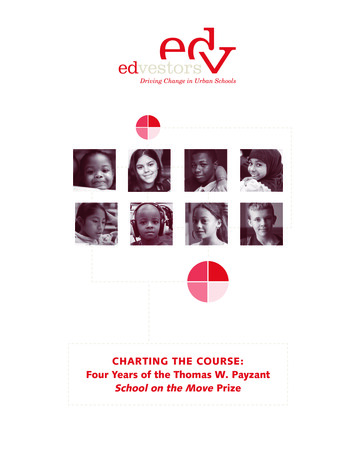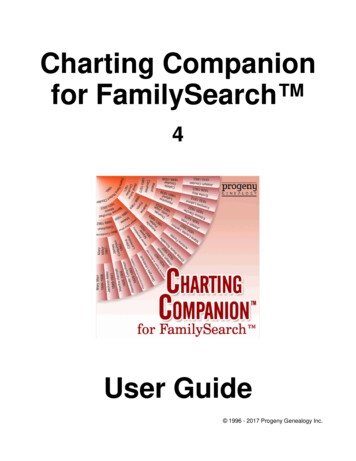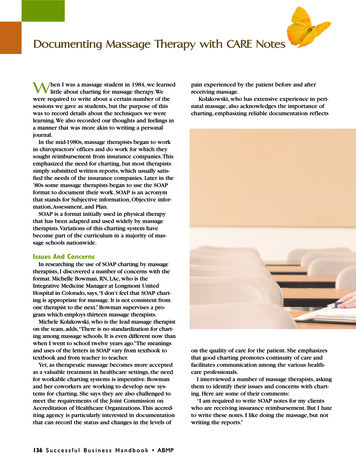
Transcription
CHARTING THE COURSE:Four Years of the Thomas W. PayzantSchool on the Move Prize
ResearchRennie Center for Education Research and PolicyJill Norton, Executive DirectorMichael Bennett, Policy AnalystProductionEdVestorsLaura Perille, Executive DirectorJanet Anderson, Associate DirectorAlison Stevens, Director of EvaluationSupport for this project provided by:The Barr Foundation, Best Practice Sponsor of the 2009 School on the Move PrizeDesignChiodo Modo Design StudioSchool on the Move Case Study Project PartnersEdVestors recognizes its partners for the production and dissemination of the School on the Move Best Practices Case Studies:AcknowledgementsEdVestors would like to recognize and thank our contributors to this project:n Jill Norton and Michael Bennett of the Rennie Center.n The hard-working members of the School on the Move Prize Panel who select the winning school each year.n T he teachers, staff, parents, principals and headmasters of all of the winning schools. We greatly appreciate their willingness toshare the important work they do on behalf of the children in their schools.About EdVestorsEdVestors drives change in urban schools through smart, strategic private investment by identifying and shaping the most effectiveinitiatives, partnering with donors to invest in these efforts, and supporting project leaders with hands-on expertise. Since its launchin 2002 by a group of philanthropists and business leaders, EdVestors has directed more than 9 million to strategic improvementefforts primarily in Boston.Each year, EdVestors hosts the innovative Urban Education Investment Showcase, where potential investors hear directly fromschool improvement leaders about projects and strategies in their schools. EdVestors also awards the Thomas W. Payzant Schoolon the Move Prize, an annual 100,000 citywide prize to one of the most improving Boston Public Schools. The Prize highlightsthe ongoing work of strengthening schools and advancing the academic achievement of all students over a four-year period. It alsosupports the sharing of best practices with other schools in and outside of Boston, with a portion of the award set aside for a casestudy documenting the successful strategies from the award-winning schools. EdVestors also coordinates the BPS Arts ExpansionFund, part of a multi-year strategic initiative to expand arts education across the Boston Public Schools.For more information about EdVestors, contact info@edvestors.org or (617) 585-5740.
Table of ContentsLetter from the Executive DirectorIntroduction. . . . . . . . . . . . . . . . . . . . . . . . . . . . . . . . . . . . . . .2.3SOM Prize Winners – 2006-2009: Case Studies in Brief . . . . . . . . . . . . . . . . . . . 4u2009 – Boston Community Leadership Academy . . . . . . . . . . . . . . . . . . . . . . 4u2008 – Samuel W. Mason Elementary School . . . . . . . . . . . . . . . . . . . . . . . . . 5u2007 – Excel High School . . . . . . . . . . . . . . . . . . . . . . . . . . . . . . . . . . . . . . . . . . . . . 6u2006 – Sarah Greenwood K-8 School . . . . . . . . . . . . . . . . . . . . . . . . . . . . . . . . . . 7Common Practices across Four Winning Schools . . . . . . . . . . . . . . . . . . . . . . . . . . 8Sustaining Success: Opportunities and Barriers. . . . . . . . . . . . . . . . . . . . . . . . .11Lessons from the Leaders . . . . . . . . . . . . . . . . . . . . . . . . . . . . . . . . . . . . . . . . . . . . . . . 14Conclusion . . . . . . . . . . . . . . . . . . . . . . . . . . . . . . . . . . . . . . . . . . . . . . . . . . . . . . . . . . . . . . 14Endnotes . . . . . . . . . . . . . . . . . . . . . . . . . . . . . . . . . . . . . . . . . . . . . . . . . . . . . . . . . . . . . . . 151
Letter from the Executive DirectorWe are pleased to share with you this report – authored by the Rennie Center for EducationResearch and Policy – which sheds light on the substance of the work in schools necessary todrive substantial improvement and better learning experiences and outcomes for children.Since 2006, EdVestors has recognized individual Boston public schools that have made significant progress in improving student achievement with the 100,000 Thomas W. PayzantSchool on the Move Prize, a rigorous quantitative and qualitative award honoring substantiveschool improvement. Each year as part of the Prize, case studies of the winning schools havebeen produced in partnership with the Rennie Center to document replicable strategies forother school leaders and educators serving urban students. This year, a four-year summativestudy was undertaken to identify common practices across all four winning schools between2006 and 2009.While much of the current dialogue around urban school improvement focuses on schoolstructure and organization, this report goes a step further to illuminate the concrete practicesthat teachers and school leaders collectively and consistently implement to accelerate studentlearning and achievement regardless of school structure. The four Prize-winning schoolsfeatured in this report – the Sarah Greenwood K-8 School (2006), Excel High School (2007),Mason Elementary School (2008) and Boston Community Leadership Academy (2009) – area diverse group: two “traditional” district schools, two pilot schools, one elementary, one K-8school and two high schools. Yet, as the report outlines, all four schools utilized a strikinglysimilar set of core practices that were central to their remarkable improvement trajectories –and benefited the children learning and growing in their schools.EdVestors’ mission is to drive change in urban schools through active engagement and strategic investment. The School on the Move Prize is a perfect example of this approach. Wethank our sponsors for making the Prize and Best Practices Studies possible, and we saluteall the members of the SOM Selection Panel who worked hard to select the winning schoolseach year. Above all, we congratulate the school communities whose stories are shared inthis report – and the educators and school leaders who strive every day to become the next“School on the Move.”Sincerely,Laura PerilleEdVestors2
C H A R T I N G T H E CO U R S E :Four Years of the Thomas W. Payzant School on the Move Prize“ The School on the Move Prize is a validation of the hard work that you do.Too often, especially in public education, it appears that we are not reallydoing a good job the Prize proves that students can get a good educationin the city of Boston and there is good teaching and learning happening.”1Harolyn Bowden, Principal, Samuel W. Mason Elementary SchoolIntroductionSince 2006, EdVestors has recognized individual Boston public schools that have made significant progress in improvingstudent achievement with the Thomas W. Payzant School on the Move Prize (SOM). Named after the former Boston PublicSchools (BPS) Superintendent, the 100,000 SOM Prize provides winning schools with a cash award of 80,000. Theremainder is used to produce case studies of winning schools to document replicable strategies for school leaders andeducators serving urban students. This year, a four-year summative study was undertaken to identify common practicesacross all four winning schools.Every spring, EdVestors invites schools that have shown improvement on the Massachusetts Comprehensive AssessmentSystem (MCAS) tests over a four-year period that are significantly (50%) greater than the district average to apply for theprize. Initial screening is based on the Composite Performance Index (CPI), a 100-point index that combines student scoreson the MCAS with those of special needs students who take the MCAS-Alternate assessment.2 Once invited, schools thatapply are subjected to a rigorous quantitative and qualitative analysis that focuses on the impact of broader school improvement strategies as well as other performance indicators, such as the achievement of certain groups of students (specifically,English language learners (ELLs), students with special needs and low-income students), graduation rates and dropout rates.To be eligible, a school’s demographic profile must be representative of the district as a whole. An independent selectionpanel reviews applications and conducts interviews and school visits to recommend finalists and select winners.In the first four years of the Prize, a diverse group of schools have emerged as winners, including two pilot schools – one ahigh school and the other an elementary school – a traditional K-8 school and a small high school occupying one floor of theSouth Boston Education Complex.3 These schools also represent the diverse neighborhoods in Boston, including Dorchester,Roxbury, Brighton, and South Boston. Despite differences in structure, governance and grades served, all four winningschools do share some similar characteristics. First, they all experienced significant structural changes in the immediate yearsprior to winning the SOM Prize that provided an opportunity for reflection and strategic planning. Second, they are all relatively small schools with lower enrollments than most comparable schools with the same grade configurations in the district.Third, they are all led by experienced educators who are strong leaders with deep knowledge of the Boston Public Schoolsystem. Finally, they all share common practices that have been critical to their success in improving student achievement,including: S hared Leadership – Shared Learning: Distributed leadership grounded in shared accountability between administrators and teachers toward a goal of instructional excellence and increased student achievement; D ata-driven Instruction: Intentional systems to use data to drive decisions about curriculum, instruction and studentsupports; A cademic Rigor and Student Support: A student-centered approach that balances high academic expectations withintegrated academic and developmental supports targeted to student needs.This study draws upon the previous SOM case studies produced by the Rennie Center for Education Research & Policy, alongwith interviews with school leaders, staff and students.4 The study identifies common themes across all four winning schoolsthat describe the structures and strategies put in place to better serve students, as well as some of the opportunities andbarriers the schools have faced in sustaining their success since winning the award. Finally, the study highlights some keylessons the leaders of these four schools view as critical to implementing the strategies and practices outlined to supportstudents and improve outcomes.3
SOM Prize Winners – 2006-2009: Case Studies in BriefBelow are one-page overviews of the four winning schools from 2006-2009. For the first three winners of the SOMPrize, these briefs outline the themes identified in previously published case studies as well as provide currentdemographic data for each school and selected MCAS data over the last three years. The 2009 winner, BostonCommunity Leadership Academy, is also described here in a one-page overview that was developed primarily frominterviews with school leadership, staff and students in the spring of 2010.5u 2009 – Boston Community Leadership Academy(Prize Review Period: 2004-2008)2009 SOM Prize winner Boston Community LeadershipAcademy (BCLA) has the distinction of being the onlyschool to have qualified all four years that the Prize hasbeen in existence. This reflects an unparalleled consistencyof performance among the most improving schools inBoston. For ten years, the school was led by HeadmasterNicole Bahnam who managed the school through itsconversion from Boston High School to a small pilot highschool in 2002. Through this process, Bahnam and herstaff worked to establish clear standards of behavior, highexpectations for student success and a mission driven bystudents’ academic and social/emotional needs. BCLA has astrong focus on college preparation and student leadershipand engagement in the community. Not only are studentsrequired to apply to five colleges as a prerequisite tograduate, but they must complete community service hoursand a senior year capstone project based on their work inthe community.BCLADemographics: 2009-2010BCLADistrictTotal enrollment:African %55,37136.5%8.6%39.6%13.1%LEP*:Low Income:Special education:Graduation Rate**:Attendance 4%91.2%*Limited English Proficient**2008-2009 school yearBCLA has been successful, in part, due to a strong collaborative culture among students, teachers and administrative staff, a high level of academic and social support forstudents, and instructional practices shaped by continualevaluation of student data. As Headmaster Bahnam notes,“We always look at our data and say, how can we improve?We never say, ‘we are there.’”MCAS Performance Data – % passingBCLA English teacher Karl Sineath describes the school as“learning centered.” Communication among staff constantlyfocuses on strategies to improve instruction based onstudent needs. All students are assessed multiple timesa year to create an academic profile that can be used totarget supports, such as the school’s Aim High tutoringprogram provided through Boston Partners for Education. As one student observed, “the adults in the schoolconstantly push us to improve academically and keep usfocused on our goals.”10th 99%99%92%Composite Performance Index (CPI)10th 64.190.295.572.0One of the more unique strategies utilized by BCLA is their community model approach to student support. Studentsare grouped into grade-level learning communities coordinated by “community leaders.” According to both teachers andstudents, the community model brings coherence to student support services by creating a single point person at each gradelevel to whom teachers, administrators, parents and students can go for resources.64
u 2008 – Samuel W. Mason Elementary School(Prize Review Period: 2003-2007)Mason Elementary, a small elementary school in Roxbury,utilizes a full inclusion model for its students with specialneeds, a population that has grown in the two years sincethe school won the SOM Prize. To more effectively servethis population of students, most teachers are dualcertified in both general and special education. The Masonconverted to pilot school status in 2003 and leveraged itsautonomy over its budget and partnerships with communityorganizations and universities to ensure there are at leasttwo adults in every classroom. The strategies utilized by theschool that were critical in its success include:Samuel W. Mason SchoolDemographics: 2009-2010MasonDistrictTotal enrollment:African 1%55,37136.5%8.6%39.6%13.1% Data-driven instructional practicesLEP*:Low Income:Special Education:Attendance Rate**:9.6%71.2%26.9%95.4%20.4%75.6%19.6%91.2% Focus on students’ social and emotional needs throughan emphasis on relationship development*Limited English Proficient**2008-2009 school year Inclusion model structured around differentiated supportsfor special education studentsMCAS Performance Data – % passing Strong commitment to families and community-building4th Grade200720082009Because of the school’s pilot status, Principal HarolynBowden has flexibility in the curriculum and in the teacherselection process to identify and hire teachers who fit themission and culture of the school. Bowden also providesteachers the opportunity to grow within their professionand take on additional roles and responsibilities.7 The PilotSchool Work Election Agreement between teachers andthe Mason, moreover, provides for 80 hours of professionaldevelopment annually, and 90 minutes of common planning time each week for teachers to collaborate, discusscurriculum and instructional strategies, and student work.Bowden, building upon efforts initiated by prior schoolleaders, has maintained a culture in the school whereteachers are integral to the decision making process andlead professional development for all staff. “When theteachers are leading [professional development], they seevalue in it. It also gives them a sense of empowerment.When they do work here they are tapped to do work atthe district level and it helps them grow [havinga leadership role in the school] can only enhance youas a teacher.”8ELAMath97%94%93%100%100%84%5th %96%91%94% Shared leadership structure focused on teacher qualityand empowermentComposite Performance Index54th h 468.584.481.578.1
u 2007 – Excel High School(Prize Review Period: 2002-2006)Excel High School was established in 2001 as part of a highschool restructuring initiative in the Boston Public Schoolsthat created smaller, more personalized schools from underperforming comprehensive high schools. The school is oneof three created from the former South Boston High School.In 2004, incoming Headmaster Ligia Noriega worked withthe staff to shift the focus of the school from a technologytheme to college preparation. The school was awarded the2007 SOM Prize based on an impressive model of teachercollaboration, an approach grounded in high expectationsand high student support, and a positive school climate thatled to significant improvements in student achievement.Excel High SchoolDemographics: 2009-2010Teachers at Excel are organized into academic departmentsand are provided common planning time to ensure bothvertical and horizontal alignment of the curriculum acrossall grades and subjects. Department chairs, moreover, serveon the instructional leadership team and provide significantopportunities for collaboration on issues of instruction andassessment.ExcelDistrictTotal enrollment:African .8%55,37136.5%8.6%39.6%13.1%LEP*:Low Income:Special Education:Graduation Rate**:Attendance 91.2%*Limited English Proficient**2008-2009 school yearMCAS Performance Data – % passingSince coming to the school, Ms. Noriega has emphasizedteacher quality and focused her energy on evaluatingteachers and providing them with appropriate professionaldevelopment and support. This effort allowed her to identify gaps in instructional competency and align the school’shuman resources in a way that better served students. Thisprocess left the staff with a high level of confidence in theirability to understand data and retool instructional strategies in a way that led to improved student performance.As Headmaster Noriega observed, “We are a faculty thatreflects on practice and takes action.”910th 4%90%88%Composite Performance IndexExcel’s success in winning the SOM Prize was predicatedin large part on maintaining consistent and high academic,civic and behavioral standards coupled with integratedsupports that address students’ academic and social/emotional needs. The school ensures consistent communication to all students, maintains the rigor and relevance ofcourses offered, and provides a number of credit recoveryand after school programs to keep students on track, particularly in the 9th grade. Finally, the school has well-alignedsupport systems to coordinate services, communicate withparents, and keep students focused on their aspirations forcollege and career after high school.10610th 61.884.382.570.5
u 2006 – Sarah Greenwood K-8 School(Prize Review Period: 2001-2005)The Sarah Greenwood K-8 School has the distinction ofbeing the inaugural SOM Prize winner, an honor thatsignaled a significant change in the school and validatedthe leadership of its principal of 22 years, Isabel Mendez.Improving student achievement has been an ongoing andat times difficult process that has seen the school maneuverthrough a transition from a K-5 to a K-8 school, the adoption of a “dual language” curriculum through which allstudents learn in both English and Spanish, and a movement toward an inclusion model for special educationstudents.11 With a population of Limited English Proficientstudents more than double the district average, the SarahGreenwood has had remarkable success in moving studentsto higher levels of proficiency, particularly students in highergrades. Despite changes to the school’s structure, staff hasmaintained a clear focus on high expectations for studentlearning and, under the direction of Mendez, has supportedthis goal through a number of key strategies: sharedinstructional leadership; data-driven decision making; and,integrated academic and social/emotional supports for allstudents. Teachers, moreover, are encouraged to be innovative and take risks.Sarah Greenwood K-8 SchoolDemographics: 2009-2010GreenwoodDistrictTotal enrollment:African %55,37136.5%8.6%39.6%13.1%LEP*:Low Income:Special Education:Attendance mited English Proficient**2008-2009 school yearMCAS Performance Data - % passingThe Sarah Greenwood uses a number of leadership teamsto address school-wide collaboration, curriculum alignment,and instructional practices. They include an instructionalleadership team, content committees for literacy, math,science and social studies, and five grade level study groups.These teams ensure that everyone is involved in decisionmaking. They provide the school flexibility to adjust quicklyto a variety of data indicators. Staff is trained to analyzeand discuss data in a way that improves student achievement. The outcomes of these discussions, moreover, shapeprofessional development. This focus on instructionalexcellence is further supported by a range of supplementalprograms:4th Grade200720082009ELAMath97%90%92%95%86%89%8th 100%62%58%Composite Performance Index Before and after school programs on literacy, math andMCAS preparation Student Support Team (SST) composed of teachers,mental health specialists, nurses, counselors andadministrators to serve the whole child Health services provided through a partnership withFranciscan Children’s Hospital74th h 944.488.558.743.3
Common Practices across Four Winning SchoolsLooking across all four SOM Prize winners, common themes emerge that have been integral to their success inaddressing student academic performance and closing achievement gaps. These include an emphasis on shared leadership grounded in strong collaborative structures and teacher empowerment, a focus on data to drive decisionsabout instructional practices and supplementary services, and a balance of high expectations for student successwith strong student support systems. Implementation of these strategies looks different from school to school, buttheir importance to overall school success is evident to students, staff and parents. Good structures and practices,however, are only part of the equation for school success. Perhaps most important is the quality of leadership andstaff, and their commitment to continuous improvement.All of these schools pay particular attention to teacher fit and development, and provide a variety of supports,including induction, coaching, and differentiated opportunities for staff to grow and take on additional responsibilities. Moreover, each school’s success in implementing a shared leadership model that both supports and empowersteachers is directly linked to strong leadership and commitment at the top. As a result, faculty report a high level ofjob satisfaction, a commitment to the values and mission of each individual school, and a willingness to put in extrahours, take risks and innovate.12 The smaller size of these schools also provides more opportunity for individualized, student-centered instruction and social support. Additionally, all of the schools benefited from going throughsignificant change in structure prior to winning the Prize, providing an opportunity to reflect on their values andleverage additional resources.1. Shared Leadership – Shared LearningSOM Prize winners share a commitment to distributed leadership, a commitment facilitated by strong leadership at eachof these schools. Decisions regarding curriculum, instruction, and student supports are made collectively among teachersand administrators, fostering a shared sense of accountability for the implementation of school-wide strategies to addressoverall learning goals. The literature on school reform has frequently mentioned the benefits of teacher collaboration andprofessional learning communities in overall school improvement strategies. Moreover, there is a growing body of empiricalevidence that suggests a positive relationship between high levels of teacher collaboration in schools and student achievement.13 These data suggest that organizational approaches to school improvement that build upon the interdependence ofstaff within a school to address shared goals creates a more coherent approach to meet student needs.The two pilot schools that have won the award, BCLA and the Mason, have used their pilot autonomies and teacher workagreements to create more time for teacher collaboration. Schedules are structured to create opportunities everyday tomeet in school-wide, departmental or grade-level teams. These learning communities provide a formal structure to discusscurriculum and instructional approaches, student work and behavior, and common assessments. Although they do not havethe autonomies of pilot schools, both the Sarah Greenwood and Excel have found innovative ways to incorporate the use ofinstructional leadership teams and common planning time to ensure a high level of teacher collaboration. Excel, for instance,has used grant money and other funds to pay teachers stipends for extra time to engage in this work. Teacher teams alsohave input on budget decisions that have a direct impact on classroom instruction. These structures foster consistency acrossthe curriculum and across grades, and empower teachers to reflect more critically on their practices and how they align withoverall school goals.8
2. Data-Driven InstructionCritical to the success of teacher leadership models in each of the winning schools is a stated commitment to teacherdevelopment. Each school leader focuses on teaching quality and provides opportunities for staff to analyze and use data ina way that leads to instructional or curricular changes designed to improve outcomes for students. A common theme amongwinning schools is the ability to remain flexible and nimble to adjust to student needs through continual analysis of studentwork and assessment data. There is a strong culture among the schools to continually improve their skills and processes tobring more clarity and consistency to how they use data to make decisions. While this can be difficult for many teacherswho are focused on the day-to-day rigors of instruction, it provides more opportunities for reflection on the ultimate objective—student learning. As Ms. Noriega from Excel stated, “We are always looking for that new perspective on student datathat will get us to think about teaching and learning in a new way.”A good example of this is BCLA’s recent shift to school-wide authentic assessments based on student portfolios and exhibitions. Determining how to analyze this rich information has been a challenge, but teachers see the value in exploringalternative ways to evaluate students’ work and academic growth. Teachers have found portfolios and exhibitions particularlyhelpful in assessing special education students and improving strategies to support these students. Within grade level teamsat the Mason and Sarah Greenwood, teachers use a wide range of formative assessments, including guided reading, writingassignments and math assessments given multiple times a year. Teachers spend a considerable amount of time and energyto ensure that their scoring rubrics are consistent and aligned to grade-level standards and expectations. It is not uncommonin these schools for 1st grade math teachers to be discussing 4th grade math to determine how to better align instruction tobuild the right foundation for successful grade-to-grade progression.Excel developed a comprehensive data inventory that outlines the type of data the school collects and its purpose. Theinventory includes ten different types of assessments, including school-based, district and state assessments, as well as datacollected on fifteen different indicators from attendance to frequency of visits to the school nurse. According to HeadmasterNoriega, analyzing all these data has expanded the school’s perspective, not only on how individual students are doing, butalso why students may or may not be achieving at a high level. Excel has been particularly effective at disaggregating datafor certain subgroups of students to create instructional practices to help close achievement gaps. Specifically, Excel wasable to successfully address two key issues in its school improvement plan—math proficiency among African-American malesand ELA proficiency among the school’s large population of Vietnamese students—through focused, data-driven instructionalchange. By focusing on both academic and non-academic indicators of student progress, Excel can better ensure that itsacademic support programs are responsive to students’ unique needs.3. Academic Rigor and Student SupportBCLA Headmaster Nicole Bahnam expressed a common sentiment in all winning schools when she said, “You cannothave high standards just for the sake of havin
CHARTING THE COURSE: Four Years of the Thomas W. Payzant School on the . Excel High School (2007), Mason Elementary School (2008) and Boston Community Leadership Academy (2009) - are a diverse group: two "traditional" district schools, two pilot schools, one elementary, one K-8 . 2009-2010 BCLA District Total enrollment: 431 55,371 .










